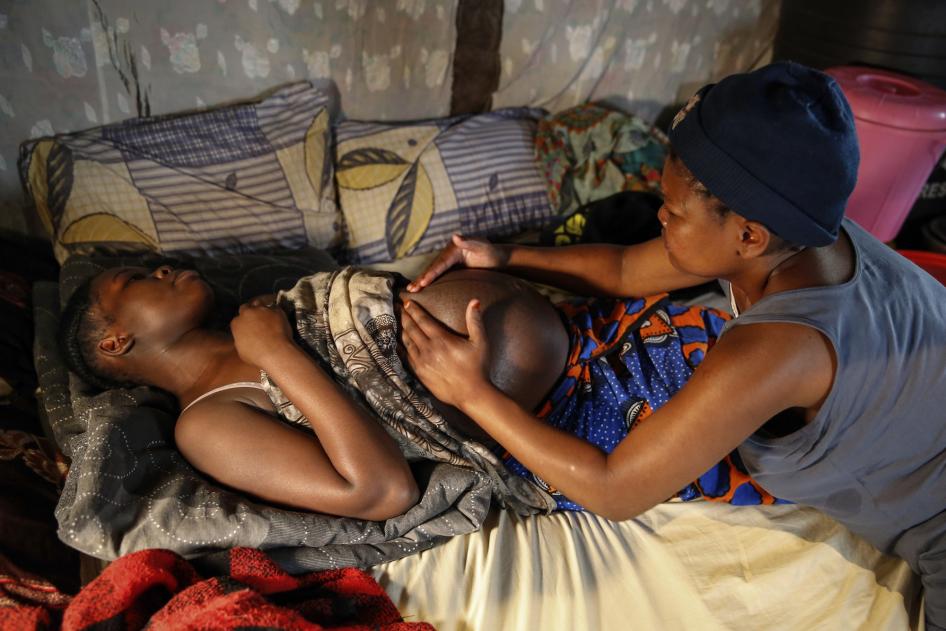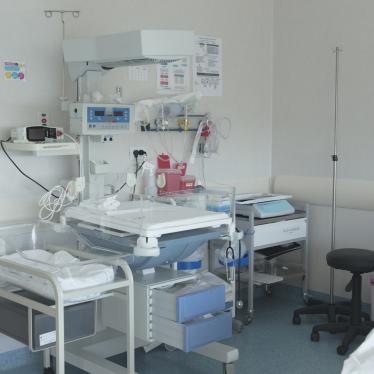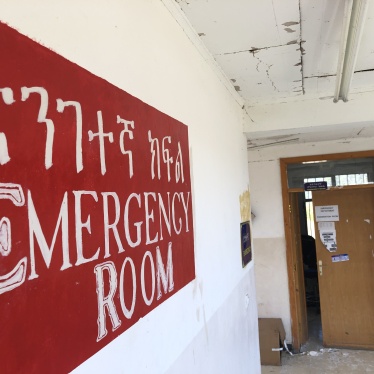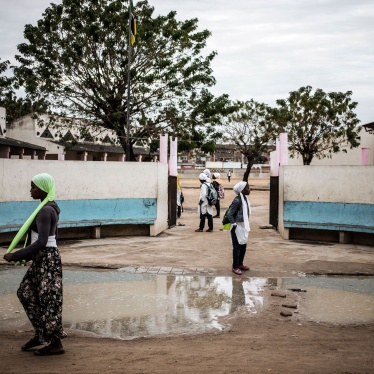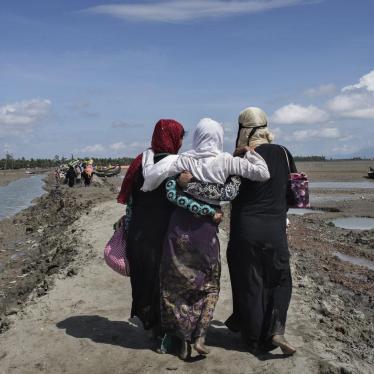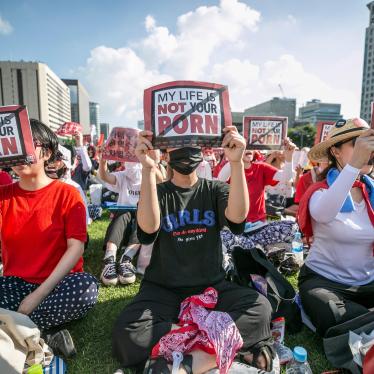Every year, over 200,000 women and girls die from pregnancy-related complications in Africa.[1] Most of these deaths are preventable with access to high-quality maternal health services. However, such services remain elusive for many women on the continent.[2] Poor quality care is wasteful, unethical, and dangerous, putting women’s lives and health at risk and causing thousands of deaths annually.[3]
Reports of abusive care are rampant, eroding trust in maternal healthcare among women and girls. Studies have shown that women seeking sexual and reproductive health care often face physical and verbal abuse, abandonment, detention,[4] coercion, and denial of pain relief and the presence of birthing companions in healthcare facilities.[5]
Women who have experienced abusive care are less likely to give birth in health facilities in the future, increasing their risk of death from complications during pregnancy, childbirth and in the post-partum period.[6] Abusive care of women seeking sexual and reproductive health services is a human rights violation and a form of gender-based violence.
Advocacy efforts have aimed to improve access to quality maternal health care, reduce maternal deaths, and make health systems more responsive to the needs of women on the continent, and they have achieved some success. However, health systems largely remain abusive, especially toward particularly vulnerable groups of women and girls such as adolescents, those with disabilities, those with HIV/AIDS, women in rural areas, and migrant and refugee women, among others.
To address these issues, there needs to be greater recognition of obstetric violence as a form of gender-based violence against women and girls. In particular, the AU Convention on Ending Violence Against Women and Girls should recognize obstetric violence as a form of violence against women and girls and include provisions for addressing it. The convention’s recognition would offer member states an additional tool to address obstetric violence and help ensure that women experience the best attainable state of sexual and reproductive health.
This Question-and-Answer document provides a comprehensive overview of obstetric violence, its prevalence in Africa, its gendered dimensions, and the associated human rights implications. It underscores the importance of recognizing abuses in the health care system as a form of violence against women and girls in the African Union (AU) Convention on Ending Violence Against Women and Girls, providing additional tools for fighting this scourge on the continent. The following questions and answers explain what obstetric violence entails, why it qualifies as gender-based violence, and how to combat this form of violence against women.
Questions and Answers on Obstetric Violence
- What is obstetric violence?
Obstetric violence is abuse of pregnant people seeking sexual and reproductive health services and information, including maternal health care -- antenatal care, intrapartum care, and post-natal care, gynecological examinations, abortion and post-abortion care, fertility treatments, and contraception.[7] This includes abusive treatment by medical practitioners, nurses, midwives, and other hospital staff,[8] including administration staff[9] and security personnel.[10]
Abusive treatment of women and girls in the health care system is a form of violence against women and girls because it consists of acts and threats against a woman or girl because of their gender[11] that inflict physical or mental harm or suffering. These acts include but are not limited to physical violence --such as beating, physical aggression, rough handling, hitting, slapping, and pinching; physical restraint --such as bed restraints, mouth gags, and post-delivery detention; and verbal abuse --such as yelling, scolding, shaming, insults, and sexist remarks.
It also entails denying women and girls autonomy and decision-making authority related to their sexual and reproductive health, such as through forced sterilization, forced treatment and denial of choice on birthing positions; and stigma and discrimination based on race, age, religion, ethnicity, socioeconomic status, national or ethnic origin, health status, or other status.
These acts involve failures to meet professional standards, including performing medically unnecessary procedures; painful vaginal examinations; refusal to provide pain relief; failure to obtain informed consent for medical procedures; breaches of confidentiality; neglect; abandonment; and prolonged delays in providing care.[12]
Obstetric Violence is meted out against diverse groups of women and girls, underscoring the need for respectful, non-discriminatory, and consent-based practices in all reproductive health services. Victims and survivors include:[13]
- Women and girls who are not pregnant but are seeking reproductive health services, such as family planning and contraception, fertility treatments, and gynecological examinations;
- Pregnant women and girls seeking maternal health care. This includes age-based discrimination against adolescent girls; lack of privacy, judgmental treatment; mistreatment of women and girls with disabilities with forced treatments, and neglect of their specific needs. It also includes women and girls experiencing miscarriages, and women with conditions such as HIV/AIDS, when health care professionals dismiss their autonomy in making health-related decisions.
- Is there a difference between “obstetric violence” and mistreatment, disrespect, and abuse during pregnancy and childbirth?
Generally speaking, no. These terms are used interchangeably.[14] For instance, the examples of acts called “obstetric violence” by the United Nations special rapporteur on violence against women[15] are the same as the examples of acts called “mistreatment”[16] and “disrespect and abuse”[17] by the World Health Organization (WHO).
These acts include non-consensual procedures such as forced sterilization and forced abortion; physically restraining pregnant people during their labor, childbirth, and post-natal period; and denial of pain medication; and unnecessary clinical interventions such as medically unjustified caesarean sections, vaginal exams, and episiotomies. The failure to respect privacy and confidentiality of patients such as sharing patients’ health information with third parties without their consent also contributes to the problem, along with denial of autonomy and decision making when accessing reproductive health services; as well as humiliation, physical violence; verbal abuse and sexist remarks, mocking, scolding, insulting, and yelling; threats of withholding treatment; and threats of negative pregnancy outcomes among others.
The term “obstetric violence” captures the structural and gendered nature of these abusive actions. It also reflects the fact that these acts are a violation of human rights and ties them to other forms of gender-based violence against women and girls.[18]
- What rights are violated by obstetric violence?
Obstetric violence violates a number of internationally protected human rights, including women and girls’ right to life; the right to the best attainable state of physical and mental health; the right to freedom from discrimination; the right to privacy; and the right to integrity and security of the person.[19] It also violates women and girls’ right to information[20] and adolescent girls’ right to be heard,[21] such as when forced or medically unnecessary procedures are carried out on women without their free and informed consent.
Acts of obstetric violence may also amount to torture or other cruel, inhuman or degrading treatment. Forced sterilization,[22] medically unnecessary caesarean sections, and other clinical procedures[23] have been found to amount to torture. Detaining patients for inability to pay bills in unsanitary conditions without access to adequate food, water, beds, or health services[24] and verbal abuse and humiliation[25] have been found to amount to cruel, inhuman or degrading treatment. The absolute prohibition of torture and other cruel, inhuman or degrading treatment extends to all acts of obstetric violence.[26]
Finally, obstetric violence is a harmful practice as it consists of behaviors and practices that affect the fundamental rights of women and girls, to life, health, dignity, education, and physical integrity.[27] As such, it violates women's and girls’ right to be protected from harmful practices.[28]
- How prevalent is obstetric violence in Africa?
Obstetric violence occurs in Africa and around the world against pregnant people across all socioeconomic levels.[29] Information about the extent of the problem in Africa is hindered by the significant gaps in data collection by African governments. It is necessary to rely on studies by nongovernmental organizations, some of which are out-of-date. These studies confirm that prevalence varies from country to country and region to region. A 2023 study estimated that 65 percent of women and girls in Ghana experienced at least one form of obstetric violence during childbirth.[30] In 2018, an estimated 77 percent of women in South Sudan had experienced at least one form of obstetric violence during childbirth.[31]And 2023 estimates indicate that 47 percent of women in the Eastern Africa region are subjected to obstetric violence during childbirth.[32]
These figures are most likely an undercount, given the underreporting of incidences of obstetric violence[33] and significant gaps in collecting data and statistics on obstetric violence in the context of other reproductive health services such as antenatal care, post-natal care, abortion care, fertility treatments, and contraceptive services.
- Why is obstetric violence a gender issue?
The abusive mistreatment of women and girls as they seek reproductive health care is clearly a gender issue,[34] but it is also clearly linked to the broader discriminatory societal norms, attitudes, and stereotypes against women and girls.
- Gendered nature of sexual and reproductive health needs: Women and girls also experience some health care conditions in a greater degree not exclusively linked to reproductive care.[35] For instance, in Eastern and Southern Africa, women and girls ages 15-24 are three times more likely to acquire HIV than boys and men in the same age range.[36] Further, barriers created by law and the practice of medicine disproportionately affect women and girls’ access to sexual and reproductive health services, including the criminalization of health services such as abortion care and the requirement for third-party consent or inclusion when seeking services.[37]
- Gendered nature of norms, attitudes, and stereotypes in healthcare settings: Patriarchal norms, attitudes and stereotypes discriminate against women and girls and result in the neglect and denial of their rights, and the normalization and justification of violence against women and girls in healthcare settings.[38] They include beliefs that diminish or disregard women and girls’ autonomy and agency, particularly when it comes to their reproductive health,[39] and false beliefs about women and pain, such as that childbirth must be a painful experience and women must bear this pain quietly.[40]
- The biased treatment and training of health care professionals, many of them women themselves, contributes to the situation. Research has found that respectful maternal healthcare requires an adequate number of competent, trained, supervised, and sufficiently remunerated healthcare professionals.[41] [42] This is not always the case and many deficiencies within health systems arise because 90 percent of sexual, reproductive, maternal, neonatal, and adolescent health professionals are women, the majority of whom are nurses and midwives,[43] who are devalued and underpaid and whose positions are treated as “women’s work.”[44]
- They are often disrespected and denied opportunities for professional development, including through further education, meaning they cannot access training to develop relevant competence. They lack adequate resources, ongoing training and support,[45] and face barriers to the use of up-to-date evidence in clinical decision-making practice.[46] A WHO study of 74 countries, including African countries, found that in 9 percent of those countries, the highest level of midwifery education is below the college degree level; in 38 percent of the countries, it is a bachelor’s degree and in only 26 percent is it a master’s degree.[47]
- Globally, women also are denied opportunities for leadership[48] and, as a result, hold only 25 percent of leadership positions in health care.[49]
- To an extent, these problems contribute to a shortage of healthcare professionals who provide sexual, reproductive, maternal, neonatal and adolescent healthcare. These shortages negatively impact the quality of care nurses and midwives provide because they work long hours and extended shifts, resulting in an increase in their stress levels, lower morale, decreased attentiveness, increased neglect and abandonment and reduced focus on patient needs.[50]
- What factors and conditions facilitate obstetric violence?Obstetric violence is facilitated by the following factors and conditions:
- Existing social and cultural norms that encourage discrimination based on gender, as well as age, race, religion, socio-economic status, national and social origin and health status.[51] These stigmatize young women and adolescents’ sexuality[52] and normalize violence against women and girls.[53] They also include discriminatory laws and policies such as those that criminalize abortion or require third-party involvement before women and girls can access reproductive health services,[54] and are used to justify verbal abuse and discrimination against women who seek those services.
- Existing social norms that institutionalize power imbalances between healthcare personnel and patients.[55]
- Normalization of healthcare personnel and other hospital staff’s behaviors and practices that amount to obstetric violence.[56]
- Insufficiently resourced health systems, including inadequate numbers of healthcare personnel; inadequate hospital facilities, including numbers of beds, spaces in wards, operating theaters, and medical equipment; and inadequate availability and accessibility of medication, including for pain management.[57]
- Inadequate training for healthcare personnel on providing respectful care, including inadequate development of the necessary skills such as communication and counseling.[58]
- Lack of accountability and oversight mechanisms, exacerbated by the absence of effective reporting channels or consequences for healthcare personnel.[59]
- Limited patient awareness and education about their rights, including to informed consent and respectful treatment, which makes it difficult for patients to advocate for themselves, thereby increasing their vulnerability to abusive practices.[60]
- What is the effect of obstetric violence on the use of reproductive health services?
Research by WHO has found that pregnant people’s experience of maternal health care, and reproductive health care as a whole, is just as important as the medical interventions.[61] Consequently, poor quality maternal health care, including obstetric violence, and the resulting negative experience —deters people from seeking maternal health care.[62] Similar trends have been seen in relation to access to contraceptive services[63]and safe abortion care.[64] - What is respectful maternity care?
The WHO defines respectful maternity care is “care organized for and provided to all women [and pregnant people] in a manner that maintains their dignity, privacy and confidentiality, ensures freedom from harm and mistreatment, and enables informed choice and continuous support during labor and childbirth.”[65] Governments have an obligation consistent with regional and international human rights law to ensure the provision of maternal health care that:
- Is free from violence and discrimination. This includes freedom from physical violence, verbal abuse, denial of care, neglect, humiliation and undignified treatment, denial of pain medication, and detention of patients.[66]
- Ensures informed consent, and supports and respects women’s autonomy and choices. At a minimum, healthcare professionals should: introduce themselves to the pregnant person and their companion(s); provide complete, clear, and concise information in a language and manner that the pregnant person would understand, including using pictures if necessary; support pregnant people to understand that they have the right to be consulted and make decisions and choices regarding their care; listen to, respect, and respond to the pregnant person’s needs, preferences, and choices; and ensure privacy and confidentiality of communications with the pregnant person and of their patient information. [67]
- Enables patients to have a companion of choice. That is, each pregnant person is allowed to choose a person from their family, friends, or network of people they know and trust to provide them with continuous support during labor. If a pregnant person prefers not to have a companion or is unable to have a companion, this must be respected and accommodations made to ensure they still get the support they need such as assigning them a nurse or midwife to accompany them through labor and delivery.[68]
- Ensures continuity of care. Continuity of care is defined by the WHO as “the degree to which a series of discrete health care events is experienced by people as coherent and interconnected over time and consistent with their health needs and preferences.”[69] In the context of maternal health care, for instance, the WHO recommends that pregnant people should have the same person or the same small group of healthcare personnel throughout their antenatal, intrapartum, and post-natal period to facilitate a healthy pregnancy, labor, and childbirth; develop healthy parenting practices through monitoring and managing any pre-existing or arising health conditions; and promote consistent and timely access to health care and health information.[70]
- Includes access to essential medicines, equipment and technology. This includes the medications in the WHO Model List of Essential Medicines.[71]
What are states’ obligations concerning sexual and reproductive health more generally?
States are the primary duty bearer when it comes to the provision of health care, whether by private or public health facilities.[72] This means that they have an obligation to protect sexual and reproductive health and rights in all health facilities, including preventing healthcare professionals and healthcare facilities from violating the right to dignified and respectful reproductive health care.States have an obligation to ensure that healthcare professionals are adequately trained to provide quality, dignified and respectful sexual and reproductive health services[73] and that they are provided in a respectful and dignified manner that does not exacerbate marginalization or vulnerability.[74]
Finally, the principles of respectful maternity care are applicable to all sexual and reproductive healthcare, not just maternal healthcare.- What should African governments do to prevent and address obstetric violence?
African governments should:
- Address patriarchal and gendered norms, attitudes, and stereotypes that result in gender-based violence, including violence against women and girls and obstetric violence as one such form, and gender-based discrimination against women healthcare professionals, including through
- Integrating gender equality content such as:[75]
- Comprehensive sexuality education in school curricula at all levels, including primary, secondary, and tertiary and including in nursing, midwifery, and programs for other healthcare personnel, including medical schools.
- Public education and information programs to raise awareness of the rights violated and the harm caused by all forms of gender-based violence and discrimination and address the stigma faced by victims and survivors.
- Laws that prohibit all forms of gender-based violence and discrimination and aligning religious, cultural, and customary laws and standards with the principle of gender equality and international and regional human rights law and standards more generally.[76]
- Integrating gender equality content such as:[75]
- Repeal laws, policies, and guidelines that promote discrimination against women and girls.[77] Repeal and eliminate:
- Laws that prevent access to safe, legal abortion care in accordance with Article 14(2)(c) of the Protocol to the African Charter on Human and Peoples’ Rights on the Rights of Women in Africa; and
- Laws and policies that require the participation of third parties including additional medical personnel, partners and/or parents before women and girls can access sexual and reproductive health care, including contraception, abortion, and antenatal care.
- Collect and make publicly available data that is disaggregated by age, marital status, and geographical location on obstetric violence that documents how obstetric violence manifests, its prevalence, and the effectiveness of existing remedies.
- Provide adequate, recurring training for all healthcare personnel, including nurses and midwives, on medical ethics and patients’ human rights, including the right to respectful and dignified care.[78]
- Ensure adequate reproductive healthcare financing, infrastructure, services and commodities, including through:
- Ensuring that reproductive health facilities are designed and furnished to enable privacy and confidentiality, including with curtains, screens, or other partitions between patients;
- Allowing women and girls to be accompanied by a companion of their choice, if the woman or girl desires this, while still ensuring privacy and confidentiality of other patients;
- Ensuring that there are an adequate number of health facilities providing the full range of quality sexual and reproductive health services and information without discrimination or exclusion on any grounds;
- Ensuring that health facilities providing sexual and reproductive health services have an adequate number of beds, spaces in wards, operating theaters, and medical equipment;
- Ensuring that health facilities have an adequate number of trained healthcare personnel, particularly through investments in the education, training, and employment of midwives and nurses as they are the best placed cadres of healthcare professionals to meet about 90 percent of the need for sexual and reproductive health services.[79]
- Ensuring that there is an adequate amount of reproductive health medication and commodities such as condoms, contraception, and pain management medication.
- Ensuring that health facilities are adequately resourced including with clean water, stable electricity, and clean accessible bathrooms in healthcare facilities.
- Ensure access to effective victim-centered remedies for victims and survivors of obstetric violence, including through ensuring that survivors and victims’ families are able to access remedies, including restitution, compensation, a declaration recognizing their rights and the violations against them, guarantees that violations won’t be repeated, and the enforcement of laws on medical ethics and malpractice. This can be accomplished through measures such as establishing an impartial oversight body within the healthcare system where survivors of obstetric violence and the families of victims of obstetric violence can lodge complaints without fear of reprisal and have them promptly investigated and resolved.
- What should AU organs do to prevent and address obstetric violence?
The AU Commission should:
- Incorporate provisions in the draft AU Convention on Ending Violence Against Women and Girls that recognize obstetric violence as a form of violence against women and girls and codifies states’ obligation to recognize, prevent, and address it.
The African Commission on Human and Peoples’ Rights should:
- Adopt a resolution, general comment and/or guidelines recognizing obstetric violence as a pervasive rights violation against women and girls in reproductive health settings and as a form of violence against women and girls.
- Take all available measures to address regression of women’s rights and sexual and reproductive health and rights,[80] including adopting a more progressive stance on women’s rights and reviewing its decision in Communication 564/15: Community Law Centre and 3 others (on behalf of the 5 victims) v. the Federal Republic of Nigeria.[81]
- Adopt and implement a resolution to conduct a study on obstetric violence in Africa that would investigate and document obstetric violence in the context of all reproductive health services and provide recommendations to states on best practices.
- Actively collaborate with other AU bodies to promote the inclusion of the subject of obstetric violence in their agenda.
The African Commission on Human and Peoples’ Rights and the African Committee of Experts on the Rights and Welfare of the Child should:
- Require states to include in their state reporting the implementation of the right to health as enshrined in the African Charter on Human and Peoples’ Rights and its Protocol on Human and Peoples’ Rights on the Rights of Women in Africa, information regarding:
- Collection and publication of disaggregated data on obstetric violence;
- Measures put in place to prevent obstetric violence; and
- Measures put in place to address obstetric violence, including measures to ensure effective remedies for survivors and the families of victims of obstetric violence.
- Collection and publication of disaggregated data on obstetric violence;
__________________
[1] World Health Organization (WHO), “WHO Recommendations: Intrapartum Care for a Positive Childbirth Experience,” 2018, https://iris.who.int/bitstream/handle/10665/260178/9789241550215-eng.pdf?sequence=1 (accessed November 11, 2024), p. 8.
[2] Jamil Tukur et al., “Quality and outcomes of maternal and perinatal care for 76,563 pregnancies reported in a nationwide network of Nigerian referral-level hospitals,” EClinicalMedicine vol. 22 no. 47 (2022): 101411, accessed November 11, 2024, doi:10.1016/j.eclinm.2022.101411.
[3] Margaret E Kruk et al., “High-quality health systems in the Sustainable Development Goals era: time for a revolution,” The Lancet global health Vol. 6 no. 11, (2018), accessed November 11, 2024, doi:10.1016/S2214-109X(18)30386-3.
[4] Human Rights Watch, A High Price to Pay: Detention of Poor Patients in Burundian Hospitals, September 2006. https://www.hrw.org/report/2006/09/07/high-price-pay/detention-poor-patients-burundian-hospitals.
[5] Anthony Idowu Ajayi et al., “Adolescents’ experience of mistreatment and abuse during childbirth: a cross-sectional community survey in a low-income informal settlement in Nairobi, Kenya,” BMJ Global Health Vol. 8 no. 11, (2023): e013268, accessed November 11, doi:10.1136/bmjgh-2023-013268; Theresa Azonima Irinyenikan et al., “Adolescent experiences of mistreatment during childbirth in health facilities: secondary analysis of a community-based survey in four countries” BMJ global health vol. 5 (2022): e007954, accessed November 11, 2024, doi:10.1136/bmjgh-2021-007954.
[6] Natnael Atnafu Gebeyehu, Gtachew Asmare Adella and Kirubel Dagnaw Tegegne, “Disrespect and abuse of women during childbirth at health facilities in Eastern Africa: systematic review and meta-analysis,” Frontiers in Medecine vol.20 no.10 (2023): 1117116, accessed November 11, 2024, doi:10.3389/fmed.2023.1117116.
[7] United Nations General Assembly, Report of the Special Rapporteur on the right to health: A human rights-based approach to mistreatment and violence against women in reproductive health services with a focus on childbirth and obstetric violence, Dubravka Šimonović, A/74/137, July 11, 2019, https://digitallibrary.un.org/record/3823693 (accessed November 11, 2024), paras. 8-9; UN Human Rights Council, Violence and its impact on the right to health: Report of the Special Rapporteur on the right of everyone to the enjoyment of the highest attainable standard of physical and mental health, Tlaleng Mofokeng, A/HRC/50/28, April 4, 2022, https://digitallibrary.un.org/record/3977977 (accessed November 11, 2024), paras. 44-45.
[8] Ibid., para. 44.
[9] Kofi Adu-Bonsaffoh, Emmanuel Tamma, Edem Maya, et al., “Health Workers’ and Hospital Administrators’ Perspectives on Mistreatment of Women during Facility-Based Childbirth: A Multicenter Qualitative Study in Ghana,” Reproductive Health (2022), accessed November 11, 2024, doi:10.1186/s12978-022-01327-y.
[10] M A O & another v Attorney General & 4 others, 2015, eKLR, para. 112; Mercy Odhiambo, “Kenya: Hatari Security suspending for denying a pregnant mother entry to a public hospital forcing her deliver at the gate,” Evening Standard, October 7, 2020, https://www.business-humanrights.org/it/ultime-notizie/kenya-hatari-security-suspended-after-denying-a-patient-entry-to-a-public-hospital-they-were-guarding/ (accessed on November 11, 2024).
[11] UN Committee on the Elimination of Discrimination against Women, General Recommendation No. 19: Violence against Women (Eleventh session, 1992), Compilation of General Comments and General Recommendations Adopted by Human Rights Treaty Bodies, UN Doc. HRI/GEN/1/Rev.1 (1994), para. 6.
[12] UN General Assembly, Report of the Special Rapporteur on the right to health: A human rights-based approach to mistreatment and violence against women in reproductive health services with a focus on childbirth and obstetric violence, Dubravka Šimonović, A/74/137, July 11, 2019, https://digitallibrary.un.org/record/3823693 (accessed November 11, 2024). paras. 15-38.
[13] Ibid.
[14] Ibid., para. 13.
[15] Ibid., paras. 19- 31.
[16]WHO, “WHO Recommendations: Intrapartum Care for a Positive Childbirth Experience,” 2018, https://iris.who.int/bitstream/handle/10665/260178/9789241550215-eng.pdf?sequence=1 (accessed November 11, 2024), pp. 20-21.
[17] WHO, “The prevention and elimination of disrespect and abuse during facility-based childbirth”, 2015, https://iris.who.int/bitstream/handle/10665/134588/WHO_RHR_14.23_eng.pdf?sequence=1 (accessed November 11, 2024), p. 1.
[18] Rhonda Waal, Kiran Mayra and Rachelle Chadwick, “Obstetric Violence: An Intersectional Refraction through Abolition Feminism,” Feminist Anthropology (2023), accessed November 11, 2024, doi:10.1002/fea2.12097.
[19] UN General Assembly, Report of the Special Rapporteur on the right to health: A human rights-based approach to mistreatment and violence against women in reproductive health services with a focus on childbirth and obstetric violence, Dubravka Šimonović, A/74/137, July 11, 2019, https://digitallibrary.un.org/record/3823693 (accessed November 11, 2024), para. 8.
[20] Ibid., para. 21-25 and 38.
[21] African Committee of Experts on the Rights and Welfare of the Child (ACERWC), “Teenage Pregnancy In Africa: Status, Progress and Challenges,” 2022, https://www.google.com/search?q=acerwc&rlz=1C1GCEA_enUS1033US1033&oq=acerwc&gs_lcrp=EgZjaHJvbWUyCQgAEEUYORiABDIHCAEQABiABDIHCAIQABiABDIHCAMQABiABDIHCAQQABiABDIHCAUQABiABDIGCAYQRRg8MgYIBxBFGDzSAQgxMzA0ajBqN6gCALACAA&sourceid=chrome&ie=UTF-8 (accessed November 11, 2024), pp. 57-59.
[22]African Commission on Human and Peoples’ Rights, General Comment No. 4, The Right to Redress for Victims of Torture and Other Cruel, Inhuman or Degrading Punishment or Treatment (Article 5), African Commission on Human and Peoples' Rights (2017), paras. 57-58.
[23]UN Human Rights Council, Violence and its impact on the right to health: Report of the Special Rapporteur on the right of everyone to the enjoyment of the highest attainable standard of physical and mental health, Tlaleng Mofokeng, A/HRC/50/28, April 4, 2022, https://digitallibrary.un.org/record/3977977 (accessed November 11, 2024), para. 50.
[24]M A O & another v Attorney General & 4 others, 2015, eKLR, paras. 100-118.
[25]The County Government of Bungoma and 2 others v Josephine Oundo Ongwen and 2 others (Civil Appeal no 61 of 2018), para. 12 as read with para. 24.
[26] UN Committee Against Torture, General Comment No. 2: Implementation of Article 2 by States Parties, U.N. Doc. CAT/C/GC/2 (2008), para. 3.
[27]Protocol to the African Charter on Human and Peoples' Rights on the Rights of Women in Africa, OAU Doc. CAB/LEG/66.6 (2003), entered into force November 25, 2005, art. 1.
[28]Ibid., art. 5.
[29] United Nations General Assembly, Report of the Special Rapporteur on the right to health: A human rights-based approach to mistreatment and violence against women in reproductive health services with a focus on childbirth and obstetric violence, Dubravka Šimonović, A/74/137, July 11, 2019, https://digitallibrary.un.org/record/3823693 (accessed November 11, 2024), para. 16.
[30] Abena A. Yalley et al., “Abuse and humiliation in the delivery room: Prevalence and associated factors of obstetric violence in Ghana,” Frontier in Public Health, vol. 11 (2023):988961, accessed November 11, 2024, doi:10.3389/fpubh.2023.988961.
[31] Awatif Altahir et al., “Proportion of Disrespectful and Abusive Care during Childbirth among Women in Khartoum State-2016,” American Journal of Public Health Research, vol. 6, no. 6 (2018): 237–242, accessed November 11, 2024, doi:10.12691/ajphr-6-6-1.
[32] Natnael Atnafu Gebeyehu et al., “Disrespect and abuse of women during childbirth at health facilities in Eastern Africa: systematic review and meta-analysis,” Frontier in Medecine vol. 10 (2023), accessed November 11, 2024, doi:10.3389/fmed.2023.1117116.
[33] Kaveri Mayra et al., “Breaking the silence about obstetric violence: Body mapping women’s narratives of respect, disrespect and abuse during childbirth in Bihar, India,” BMC Pregnancy and Childbirth (2022), accessed November 11, 2024, doi:10.1186/s12884-022-04997-8.
[34]UN Human Rights Council, Violence and its impact on the right to health: Report of the Special Rapporteur on the right of everyone to the enjoyment of the highest attainable standard of physical and mental health, Tlaleng Mofokeng, A/HRC/50/28, April 4, 2022, https://digitallibrary.un.org/record/3977977 (accessed November 11, 2024), para. 44.
[35] “Sexual and Reproductive Health,” WHO- Africa Region, accessed November 11, 2024, https://www.afro.who.int/health-topics/sexual-and-reproductive-health.
[36] UNAIDS, “Regional Profile: Eastern and Southern Africa,” 2024, https://www.unaids.org/sites/default/files/media_asset/2024-unaids-global-aids-update-eastern-southern-africa_en.pdf (accessed on November 11, 2024).
[37]Adolescent maternal health services utilization and associated barriers in Sub-Saharan Africa: A comprehensive systematic review and meta-analysis before and during the sustainable development goals,” Heliyon, vol. 10, no. 15 (2024), accessed November 11, 2024, doi: 10.1016/j.heliyon.2024.e35629; UN Committee on the Elimination of Discrimination against Women (CEDAW Committee), General Recommendation No. 24, Article 12 of the Convention (women and health), U.N. Doc. A/54/38/Rev.1 (1999), para. 14.
[38] CEDAW Committee, General Recommendation No. 35 on Gender-Based Violence Against Women, Updating General Recommendation No. 19, U.N. Doc. CEDAW/C/GC/35 (2017), para. 34; UN Human Rights Council, Violence and its impact on the right to health: Report of the Special Rapporteur on the right of everyone to the enjoyment of the highest attainable standard of physical and mental health, Tlaleng Mofokeng, A/HRC/50/28, April 4, 2022, https://digitallibrary.un.org/record/3977977 (accessed November 11, 2024), paras. 44-51.
[39]United Nations General Assembly, Report of the Special Rapporteur on the right to health: A human rights-based approach to mistreatment and violence against women in reproductive health services with a focus on childbirth and obstetric violence, Dubravka Šimonović, A/74/137, July 11, 2019, https://digitallibrary.un.org/record/3823693 (accessed November 11, 2024), para. 46.
[40] Thorgaard-Rasmussen et al., “Women's and maternity care providers' perceptions of pain management during childbirth in hospitals in Southern Tanzania,” BMC Pregnancy and Childbirth vol. 24, no. 1, (2024): 1-12, accessed November 11, 2024, doi: 10.1186/s12884-024-06606-9.
[41]WHO, “WHO Recommendations: Intrapartum Care for a Positive Childbirth Experience,” 2018, https://iris.who.int/bitstream/handle/10665/260178/9789241550215-eng.pdf?sequence=1 (accessed November 11, 2024), p. 22.
[42] Yohannes Mehretie Adinew et al., “Care Providers' Perspectives on Disrespect and Abuse of Women During Facility-Based Childbirth in Ethiopia: A Qualitative Study,” International Journal of Women’s Health vol. 13 (2021): 553-561, accessed November 11, 2024, doi:10.2147/IJWH.S312942.
[43] Rahel Tesfa Maregn et al., “Qualitative Study of the Roles of Midwives in the Provision of Sexual and Reproductive Healthcare Services in the Somaliland Health System,” BMJ Open vol. 13, no. 3 (2023): e067315, accessed November 11, 2024, doi:10.1136/bmjopen-2022-067315.
[44] International Council of Nurses, “New reports reveal nurses are underpaid, undervalued and face larger gender pay gap than other sectors,”July 14, 2022, https://www.icn.ch/news/new-reports-reveal-nurses-are-underpaid-undervalued-and-face-larger-gender-pay-gap-other (accessed November 11, 2024); WHO and International Labour Organization (ILO), “The gender pay gap in the Health and Care sector: A global analysis in the time of COVID-19,” 2022, https://www.ilo.org/sites/default/files/wcmsp5/groups/public/%40dgreports/%40dcomm/%40publ/documents/publication/wcms_850909.pdf (accessed November 11, 2024), p. 36.
[45] Yohannes Mehretie Adinew et al., “Care Providers' Perspectives on Disrespect and Abuse of Women During Facility-Based Childbirth in Ethiopia: A Qualitative Study,” International Journal of Women’s Health vol. 13 (2021): 553-561, accessed November 11, 2024, doi:10.2147/IJWH.S312942.
[46] United Nations General Assembly, Report of the Special Rapporteur on the right to health: A human rights-based approach to mistreatment and violence against women in reproductive health services with a focus on childbirth and obstetric violence, Dubravka Šimonović, A/74/137, July 11, 2019, https://digitallibrary.un.org/record/3823693 (accessed November 11, 2024), para. 27.
[47] United Nations Populations Fund (UNFPA), WHO and International Confederation of Midwives (ICM) “The State of the World’s Midwifery 2021,” 2021, https://cdn.who.int/media/docs/default-source/health-workforce/hwp/2021-sowmy-unfpa.pdf?sfvrsn=46d2bd54_3&download=true (accessed November 11, 2024), p. 16.
[48] Yohannes Mehretie Adinew et al., “Care Providers' Perspectives on Disrespect and Abuse of Women During Facility-Based Childbirth in Ethiopia: A Qualitative Study,” International Journal of Women’s Health vol. 13 (2021): 553-561, accessed November 11, 2024, doi:10.2147/IJWH.S312942.
[49] WHO, Global Health Workforce Network (GHWN) and Women in Global Health (WGH), “Closing the leadership gap: gender equity and leadership in the global health and care workforce,” 2021, https://iris.who.int/bitstream/handle/10665/341636/9789240025905-eng.pdf?sequence=1 (accessed November 11, 2024), p. 2.
[50]The County Government of Bungoma and 2 others v Josephine Oundo Ongwen and 2 others (Civil Appeal no 61 of 2018).
[51] United Nations General Assembly, Report of the Special Rapporteur on the right to health: A human rights-based approach to mistreatment and violence against women in reproductive health services with a focus on childbirth and obstetric violence, Dubravka Šimonović, A/74/137, July 11, 2019, https://digitallibrary.un.org/record/3823693 (accessed November 11, 2024), paras. 42-48.
[52]African Committee of Experts on the Rights and Welfare of the Child (ACERWC), “Teenage Pregnancy In Africa: Status, Progress and Challenges,” 2022, https://www.google.com/search?q=acerwc&rlz=1C1GCEA_enUS1033US1033&oq=acerwc&gs_lcrp=EgZjaHJvbWUyCQgAEEUYORiABDIHCAEQABiABDIHCAIQABiABDIHCAMQABiABDIHCAQQABiABDIHCAUQABiABDIGCAYQRRg8MgYIBxBFGDzSAQgxMzA0ajBqN6gCALACAA&sourceid=chrome&ie=UTF-8 (accessed November 11, 2024), pp. 13-14.
[53] Yohannes Mehretie Adinew et al., “Care Providers' Perspectives on Disrespect and Abuse of Women During Facility-Based Childbirth in Ethiopia: A Qualitative Study,” International Journal of Women’s Health vol. 13 (2021): 553-561, accessed November 11, 2024, doi:10.2147/IJWH.S312942.
[54] WHO, “WHO recommendations on adolescent sexual and reproductive health and rights,” 2022, https://iris.who.int/bitstream/handle/10665/275374/9789241514606-eng.pdf (accessed November 11, 2024), p. 24-25;USAID and Health Policy Plus, “Assessment of By-Laws Related to Maternal, Child, and Reproductive Health in Malawi,” 2020, http://www.healthpolicyplus.com/ns/pubs/16344-17703_MalawiBylawsReport.pdf (accessed November 11, 2024)..
[55]Government of the Republic of Namibia v LM, 2014, NASC 19, paras. 103-106.
[56]WHO, “WHO Recommendations: Intrapartum Care for a Positive Childbirth Experience,” 2018, https://iris.who.int/bitstream/handle/10665/260178/9789241550215-eng.pdf?sequence=1 (accessed November 11, 2024), p. 23.
[57]Ibid., p. 24.
[58]Ibid., p. 25-26.
[59] United Nations General Assembly, Report of the Special Rapporteur on the right to health: A human rights-based approach to mistreatment and violence against women in reproductive health services with a focus on childbirth and obstetric violence, Dubravka Šimonović, A/74/137, July 11, 2019, https://digitallibrary.un.org/record/3823693 (accessed November 11, 2024), para. 81(i)-(n).
[60] CEDAW Committee, General Recommendation No. 35 on Gender-Based Violence Against Women, Updating General Recommendation No. 19, U.N. Doc. CEDAW/C/GC/35 (2017), para. 35.
[61]WHO, “WHO Recommendations: Intrapartum Care for a Positive Childbirth Experience,” 2018, https://iris.who.int/bitstream/handle/10665/260178/9789241550215-eng.pdf?sequence=1 (accessed November 11, 2024), p. 8.
[62] Ibid; WHO, “WHO recommendations on maternal and newborn care for a positive postnatal experience,” 2022, https://iris.who.int/bitstream/handle/10665/352658/9789240045989-eng.pdf?sequence=1 (accessed November 11, 2024), p. 156. WHO, “WHO recommendations on antenatal care for a positive pregnancy experience,” 2016, https://iris.who.int/bitstream/handle/10665/259947/WHO-RHR-18.02-eng.pdf (accessed November 11, 2024), p. 105.
[63] Luchuo Engelbert Bain, Hubert Amu and Elvis Enowbeyang Tarkang., “Barriers and motivators of contraceptive use among young people in Sub-Saharan Africa: A systematic review of qualitative studies,” PLoS One vol. 16, no. 6 (2021): e0252745, accessed November 11, 2024, doi: 10.1371/journal.pone.0252745.
[64]International Federation of Gynaecology and Obstetrics, “Addressing Barriers to Safe Abortion,” 2021, https://www.figo.org/resources/figo-statements/addressing-barriers-safe-abortion (accessed on November 11, 2024).
[65]WHO, “WHO Recommendations: Intrapartum Care for a Positive Childbirth Experience,” 2018, https://iris.who.int/bitstream/handle/10665/260178/9789241550215-eng.pdf?sequence=1 (accessed November 11, 2024), p. 19.
[66]The County Government of Bungoma and 2 others v Josephine Oundo Ongwen and 2 others (Civil Appeal no 61 of 2018).)
[67] Committee on Economic, Social and Cultural Rights, General Comment No. 22, The Right to Sexual and Reproductive Health (Article 12 of the International Covenant on Economic, Social and Cultural Rights), U.N. Doc. E/C.12/GC/22 (2016), para. 49.; WHO, “WHO Recommendations: Intrapartum Care for a Positive Childbirth Experience,” 2018, https://iris.who.int/bitstream/handle/10665/260178/9789241550215-eng.pdf?sequence=1 (accessed November 11, 2024), p. 25.
[68]Ibid., p. 29.
[69] WHO, “Continuity and coordination of care: a practice brief to support implementation of the WHO Framework on integrated people-centred health services,” 2018, https://iris.who.int/bitstream/handle/10665/274628/9789241514033-eng.pdf?sequence=1&isAllowed=y (accessed November 11, 2024), p. 8.
[70]WHO, “WHO Recommendations: Intrapartum Care for a Positive Childbirth Experience,” 2018, https://iris.who.int/bitstream/handle/10665/260178/9789241550215-eng.pdf?sequence=1 (accessed November 11, 2024), p. 34.
[71] CESCR, General Comment No. 22, The Right to Sexual and Reproductive Health (Article 12 of the International Covenant on Economic, Social and Cultural Rights), U.N. Doc. E/C.12/GC/22 (2016), para. 49.
[72] African Commission on Human and Peoples’ Rights. General Comment 7: State Obligations under the African Charter on Human and Peoples’ Rights in the Context of Private Provision of Social Services. 2022, 20–29.
[73] CESCR, General Comment No. 22, The Right to Sexual and Reproductive Health (Article 12 of the International Covenant on Economic, Social and Cultural Rights), U.N. Doc. E/C.12/GC/22 (2016), para. 46.
[74] Ibid., para. 24.
[75] CEDAW Committee, General Recommendation No. 35 on Gender-Based Violence Against Women, Updating General Recommendation No. 19, U.N. Doc. CEDAW/C/GC/35 (2017), para. 35.
[76]Protocol to the African Charter on Human and Peoples' Rights on the Rights of Women in Africa, OAU Doc. CAB/LEG/66.6 (2003), entered into force November 25, 2005, art. 2.
[77] CESCR, General Comment No. 22, The Right to Sexual and Reproductive Health (Article 12 of the International Covenant on Economic, Social and Cultural Rights), U.N. Doc. E/C.12/GC/22 (2016), para. 49(a).
[78] Adu-Bonsaffoh et al., “Health Workers’ and Hospital Administrators’ Perspectives on Mistreatment of Women During Facility-Based Childbirth: A Multicenter Qualitative Study in Ghana.” Reproductive Health (2022), accessed November 11, 2024, doi:10.1186/s12978-022-01456-7;See: United Nations General Assembly, Report of the Special Rapporteur on the right to health: A human rights-based approach to mistreatment and violence against women in reproductive health services with a focus on childbirth and obstetric violence, Dubravka Šimonović, A/74/137, July 11, 2019, https://digitallibrary.un.org/record/3823693 (accessed November 11, 2024), para. 40.
[79] UNFPA, WHO and ICM, “The State of the World’s Midwifery 2021,” 2021, https://cdn.who.int/media/docs/default-source/health-workforce/hwp/2021-sowmy-unfpa.pdf?sfvrsn=46d2bd54_3&download=true (accessed November 11, 2024), p. 28.
[80] Hon. Vice-Chair Janet Ramatoulie Sallah-Njie, Special Rapporteur On The Rights Of Women In Africa, African Commission on Human and People’s Rights “Intersession Activity Report” 2024, https://achpr.au.int/en/intersession-activity-reports/rights-women-africa (accessed on November 11, 2024).
[81] Community Law Centre and Others (on behalf on the Five Victims) v Federal Republic of Nigeria (Communication 564 of 2015)..


